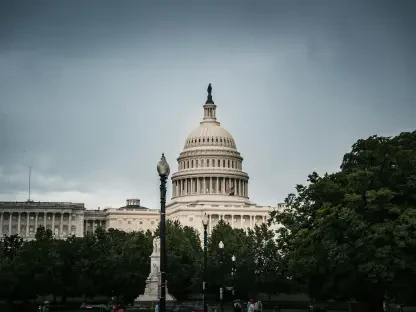In a development that could influence countless homebuyers across the United States, mortgage rates have experienced a subtle yet significant uptick as of August 11, with the widely tracked 30-year fixed-rate mortgage (FRM) edging up to 6.74%, marking a rise of 6 basis points from the previous week. This incremental shift might seem minor at first glance, but it underscores a broader trend of increasing borrowing costs that could reshape decisions in the housing market. Amid lingering economic uncertainties, including persistent inflation and slow growth, this change prompts a closer examination of what drives these rates and how they impact prospective buyers and refinancers. With the Federal Reserve’s policies and economic forecasts playing pivotal roles, understanding the current landscape becomes essential for anyone navigating the complexities of home financing. This slight rise serves as a reminder that even small fluctuations can carry substantial weight over the long term, setting the stage for a deeper dive into the dynamics at play.
Slight Uptick in Purchase Rates
The recent climb in the 30-year fixed mortgage rate to 6.74% signals a gradual increase in the cost of homeownership for many Americans looking to secure a loan. For a typical $300,000 loan, this translates to a monthly payment of approximately $1,943, up slightly from $1,935 just a month earlier when rates were at 6.68%. While the difference may appear negligible on a monthly basis, over the life of a 30-year loan, these incremental increases can add thousands of dollars in interest payments. This trend reflects broader pressures in the financial markets, where lenders adjust rates in response to economic indicators and policy expectations. Homebuyers now face the challenge of budgeting for these higher costs, which could influence decisions on how much house they can afford or whether to delay purchasing until a more favorable rate environment emerges. The slow but steady rise in rates serves as a critical factor in shaping market sentiment and planning.
Beyond the headline figure of the 30-year FRM, the slight uptick in purchase rates highlights a shifting landscape where affordability remains a pressing concern for many. This increase is particularly impactful for first-time buyers or those with tighter budgets, as even a small rate hike can push monthly payments beyond comfortable limits. Lenders are closely monitoring economic signals, and this adjustment in rates often reflects caution about inflation and growth prospects. For families and individuals eager to enter the housing market, the current environment necessitates careful financial planning and possibly exploring alternative loan products or down payment assistance programs. The reality of higher borrowing costs may also drive some to reconsider their timelines, opting to save more for a larger down payment to offset the impact of elevated rates. As the market continues to evolve, staying informed about these changes becomes paramount for making sound decisions in a competitive real estate arena.
Mixed Movements Across Loan Types
While the 30-year fixed mortgage rate garners much attention with its rise to 6.74%, other loan types present a more varied picture that could offer opportunities for certain borrowers. Shorter-term fixed-rate mortgages, such as the 15-year option at 5.77%, have actually seen a slight decline, providing an attractive choice for those who can manage higher monthly payments in exchange for paying off their loan faster and saving on total interest. This divergence in rate movements between longer and shorter terms reflects differing lender expectations and risk assessments in the current economic climate. Borrowers prioritizing long-term savings might find these lower rates on shorter loans appealing, though they must weigh the trade-off of increased monthly financial strain. This mixed trend across fixed-rate products illustrates the complexity of the mortgage market, where not all rates move in lockstep.
In contrast to the stability or slight declines in fixed-rate options, adjustable-rate mortgages (ARMs) have shown more pronounced increases, with the 5-year ARM jumping to 7.40%. This significant rise underscores the higher risk associated with variable-rate loans, especially in an environment where future rate hikes remain a possibility due to economic uncertainties. Borrowers opting for ARMs often do so hoping for lower initial rates, but the current upward trajectory suggests potential financial challenges if rates continue to climb after the initial fixed period. This disparity between fixed and adjustable rates highlights the importance of understanding loan structures and personal risk tolerance when choosing a mortgage product. For those considering ARMs, the current data serves as a cautionary note to carefully assess future affordability under potentially higher rates, emphasizing the need for thorough financial planning in a volatile market.
Federal Reserve’s Role in Rate Dynamics
The Federal Reserve’s monetary policy stands as a dominant force shaping the trajectory of mortgage rates, with significant anticipation surrounding its next moves. With an 89% likelihood of a rate cut in September, as indicated by the CME FedWatch tool, there is hope among borrowers for some relief in borrowing costs. However, despite earlier rate reductions in the prior year, persistent inflationary pressures and sluggish economic growth—with GDP growth recorded at just 1.2% in the first half of the year—continue to exert upward pressure on mortgage rates. This tension between the Fed’s efforts to stimulate the economy and the stubborn economic headwinds creates a challenging environment for predicting rate movements. The central bank’s decisions are closely watched by lenders and borrowers alike, as even small policy shifts can ripple through the housing market with substantial impact.
Adding to the complexity, the Federal Reserve must balance the dual goals of curbing inflation while fostering economic growth, a delicate act that directly influences mortgage rate trends. The current economic backdrop, marked by inflation rates still above target levels, limits the extent to which the Fed can lower rates without risking further price increases across sectors. This cautious approach means that while a September cut is probable, it may not lead to dramatic drops in mortgage rates immediately. Lenders, in turn, price loans with these broader uncertainties in mind, often maintaining higher rates as a buffer against potential economic downturns. For borrowers, this dynamic suggests a period of sustained vigilance, as the interplay between Fed policy and economic indicators will likely keep rates elevated in the near term. Understanding this relationship is key to anticipating how future announcements might alter the cost of home financing.
What Lies Ahead for Mortgage Rates
Looking into the near future, expert forecasts provide a glimpse into the expected path of mortgage rates, with a consensus forming around cautious stability. Projections from reputable organizations like the National Association of REALTORS® and Fannie Mae suggest that the 30-year fixed rate will likely hover between 6.1% and 6.8% by the end of the year, with a gradual decline possibly extending into the following year. This range indicates that while some easing may occur, a return to the ultra-low rates seen in previous years remains unlikely for the foreseeable future. These predictions are grounded in ongoing concerns about inflation and economic recovery, which could delay more significant rate reductions. For those planning to buy or refinance, these forecasts underscore the importance of setting realistic expectations and preparing for a market where borrowing costs remain relatively high.
Further elaborating on these projections, the diversity in expert opinions reflects the inherent uncertainty in economic forecasting, particularly in a climate shaped by fluctuating indicators. While some analysts anticipate a slow downward trend in rates if the Federal Reserve implements anticipated cuts, others warn that persistent inflation or unexpected economic slowdowns could keep rates at the higher end of the predicted spectrum. This variability suggests that borrowers should remain adaptable, ready to act if rates dip but also prepared for the possibility of sustained or even slightly higher rates. The housing market, influenced by these projections, may see shifts in buyer behavior, with some choosing to act sooner to lock in current rates, while others hold off in hopes of better conditions. Keeping abreast of these evolving forecasts and their underlying assumptions will be crucial for making informed decisions in a landscape that shows no signs of rapid change.
Impact on Homebuyers
For homebuyers, the incremental rise in the 30-year fixed rate to 6.74% presents a tangible challenge in an already competitive housing market, requiring careful consideration of financial strategies. This uptick means that purchasing a home now could lock in higher monthly payments, potentially stretching budgets for many, especially first-time buyers or those in high-cost areas. The decision to buy now or wait for potential rate decreases involves weighing the certainty of current terms against the gamble of future economic shifts. With indications pointing to sustained high rates through the year, securing a fixed-rate mortgage might offer more predictability, particularly if economic conditions deteriorate further. Homebuyers are encouraged to explore all available options, including assistance programs or adjusting expectations on property size and location, to mitigate the impact of these rising costs.
Additionally, the broader implications of higher mortgage rates extend to overall market dynamics, influencing both demand and pricing trends in real estate. As borrowing becomes more expensive, some buyers may be priced out, potentially cooling demand in certain segments and affecting home price growth. This could lead to a more balanced market in some regions, though it also means that sellers might need to adjust expectations on offers. For prospective buyers, this environment necessitates a thorough evaluation of long-term affordability, factoring in not just the current rate but also potential increases in property taxes or maintenance costs over time. Consulting with financial advisors or mortgage professionals can provide clarity on navigating these challenges, ensuring that decisions align with both immediate needs and future financial stability in a market where every basis point counts.
Opportunities for Refinancers
Refinancers find themselves in a slightly different position, with the 30-year fixed refinance rate holding steady at 6.99%, prompting a strategic wait-and-see approach among many. For those currently locked into loans with rates above 7%, the stability in refinance rates suggests that patience could pay off, especially with the possibility of a Federal Reserve rate cut on the horizon in September. A reduction in the federal funds rate could lower refinancing costs, offering substantial savings on monthly payments and overall interest over the life of the loan. However, timing such a move requires careful monitoring of economic announcements and market trends, as acting too soon might mean missing out on better rates later. Refinancers must balance the potential benefits of waiting against the risk of rates remaining elevated or even increasing if economic conditions shift unexpectedly.
Moreover, the current stability in refinance rates provides an opportunity for borrowers to reassess their financial goals and explore whether refinancing aligns with broader objectives, such as debt consolidation or accessing home equity. For homeowners who took out loans during periods of higher rates, even a small drop following a Fed cut could make refinancing a viable option to reduce monthly burdens or shorten loan terms. This scenario emphasizes the importance of staying informed about policy developments and maintaining flexibility in financial planning. Borrowers in this category might benefit from working with lenders to understand break-even points on refinancing costs versus savings, ensuring that any decision maximizes long-term value. As the market continues to evolve, the potential for favorable conditions later in the year remains a key consideration for those looking to optimize their mortgage terms.
Navigating Future Uncertainties
Reflecting on the mortgage rate landscape as it stood on August 11, the slight rise in the 30-year FRM to 6.74% captured a moment of cautious adjustment in a market shaped by economic complexities. The mixed trends across loan types and the steady refinance rates at 6.99% painted a picture of a housing finance environment where strategic patience was often advised. Moving forward, borrowers were encouraged to closely track Federal Reserve actions, particularly the anticipated September policy moves, as these could unlock more favorable borrowing conditions. Homebuyers needed to balance the urgency of securing a property against the cost of higher rates, possibly exploring shorter-term loans for savings. Refinancers, meanwhile, were prompted to prepare for potential opportunities by reviewing current loan terms and setting alerts for rate drops. Staying proactive with financial planning and seeking expert guidance emerged as vital steps to navigate the uncertainties that lay ahead in the mortgage market.









